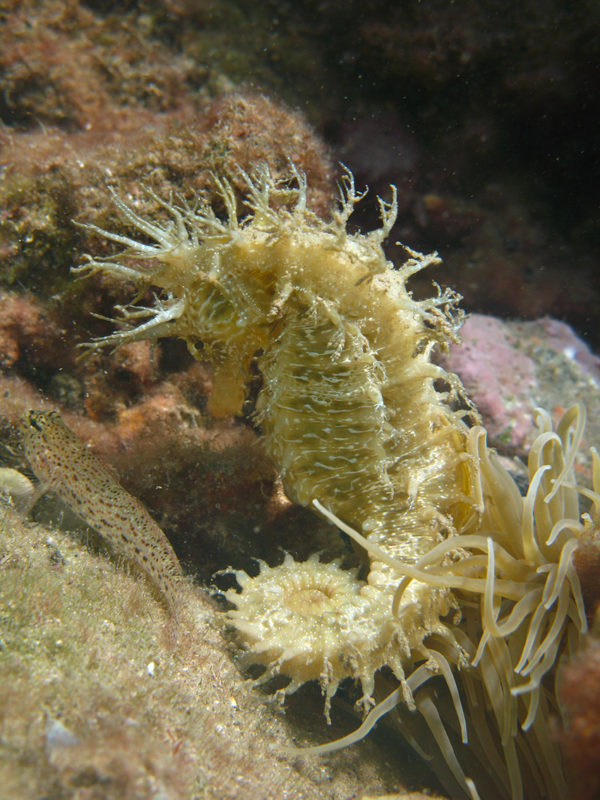3.9. Hippocampus, a peculiar fish
Seahorse is the name given to 54 species of small marine fishes in the genus Hippocampus. “Hippocampus” comes from the Ancient Greek word hippos meaning “horse” and kampos meaning “sea monster”. Having a head and neck suggestive of a horse, seahorses also feature segmented bony armour, an upright posture and a curled prehensile tail. Although they are bony fish, they do not have scales, but rather thin skin stretched over a series of bony plates, which are arranged in rings throughout their bodies. Each species has a distinct number of rings. Seahorses swim upright, another characteristic not shared by their close pipefish relatives, which swim horizontally. They swim upright propelling themselves by using the dorsal fin. The pectoral fins located on either side of the head are used for maneuvering. They lack the caudal fin typical of fishes. Since they are poor swimmers, they are most likely to be found resting with their prehensile tails wound around a stationary object.
Seahorses are mainly found in shallow tropical and temperate waters throughout the world, and live in sheltered areas such as seagrass beds, estuaries, coral reefs, or mangroves. Three species live in the Mediterranean Sea: H. guttulatus (the long-snouted seahorse), H. hippocampus (the short-snouted seahorse), and H. fuscus (the sea pony). These species form territories; males stay within 1 m2 of habitat, while females range about one hundred times that.
Seahorses feed on small crustaceans floating in the water or crawling on the bottom. With excellent camouflage and patience, seahorses ambush prey that floats within striking range. The distinctive head morphology was found to give it a hydrodynamic advantage that creates minimal interference while approaching an evasive prey. Therefore, the seahorse has the ability to come within a very close range of the copepods on which they prey. After successfully closing in on the prey without alerting it, the seahorse gives an upward thrust rapidly rotates the head aided by large tendons that store and release elastic energy, to bring its long snout close to the prey. This step is crucial for prey capture as suction only works with the mouth at a close range. This two-phase prey capture mechanism is termed pivot-feeding. While feeding, they produce a distinctive click each time a food item is ingested. The same clicks are heard with social interactions.
The male seahorse is equipped with a pouch on the ventral, or front-facing, side of the tail. When mating, the female seahorse deposits up to 1.500 fertilized eggs in the male’s pouch. The male supplies the eggs with prolactin, the same hormone responsible for milk production in pregnant mammals. The pouch provides oxygen, as well as a controlled environment incubator. Though the egg yolk contribute nourishment to the developing embryo, the male seahorses contribute additional nutrients such as energy-rich lipids and also calcium to allow them to build their skeletal system. The male carries the eggs for 9 to 45 days. The eggs then hatch in the pouch, where the salinity of the water is regulated; this prepares the newborns for life in the sea. The fully developed, but very small seahorses are then released into the water, and the male often mates again within hours or days during the breeding season. The number of young released by the male seahorse averages 100–1000 for most species. Like almost all other fish species, seahorses do not nurture their young after birth.
Hippocampus guttulatus, commonly known as the long-snouted seahorse, is a small-sized fish that can reach a maximum length of 21.5 cm but the average size is more or less 12 cm. The body is slender, the snout is long and the tail is prehensile. Its head and dorsal ridge have often some more or less long and numerous dermal filaments which can be simple or bifid. Its color ranges from dark green to different variants of brown to yellow, the body is often speckled with small white dots. This seahorse likes shallow coastal waters from 1 to 20 m deep. It occurs close by Posidonia and eelgrass meadows or in mixed habitat with sandy bottom and rocks with algae. The long-snouted seahorse is relatively rare and limited data exist on its population and about the volume and the impact of trade for the traditional Chinese medicine and for the aquarium, thus the species is considered as “Data Deficient” on the IUCN Red List.

The short-snouted seahorse (Hippocampus hippocampus) is endemic to the Mediterranean Sea and parts of the North Atlantic, particularly around Italy and the Canary Islands. Their preferred habitat is shallow muddy waters, estuaries or seagrass beds. Hippocampus hippocampus has potential to be up to 15 cm long. They have a prominent spine above each eye. They have snouts that are short (about 1/3 of the length of their head) and upturned. Their dorsal fin has a dark stripe that runs parallel to the margin and provides propulsion. Their pectoral fins are located below the gill openings. Their pectoral fins are mostly utilized for stability and steering. Their bodies can be black, purple, orange or brown. They have a tail that is unable to bend backwards but is considered semi-flexible. They use it as an anchor by wrapping it around coral or sea grass. The tail is also used to get hold of a partner during greeting and mating services.

